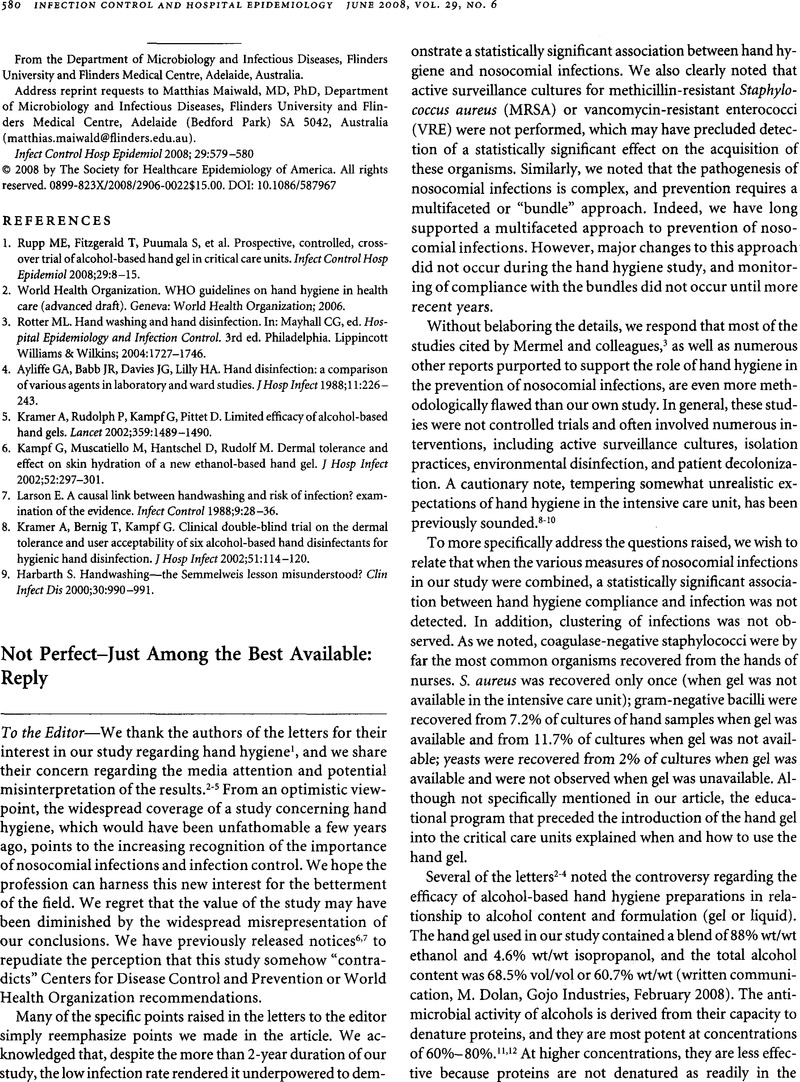No CrossRef data available.
Article contents
Not Perfect-Just Among the Best Available: Reply
Published online by Cambridge University Press: 02 January 2015
Abstract
An abstract is not available for this content so a preview has been provided. As you have access to this content, a full PDF is available via the ‘Save PDF’ action button.

- Type
- Letters to the Editor
- Information
- Copyright
- Copyright © The Society for Healthcare Epidemiology of America 2008
References
1.Rupp, M, Fitzgerald, T, Puumala, S, et al. Prospective, controlled, crossover trial of alcohol-based hand gel in critical care units. Infect Control Hosp Epidemiol 2008;29:8–15.Google Scholar
2.Maiwald, M. Alcohol-based hand hygiene and nosocomial infection rates. Infect Control Hosp Epidemiol 2008;29:579–580.CrossRefGoogle ScholarPubMed
3.Mermel, LA, Boyce, JM, Voss, A, Allegranzi, B, Pittet, D. Trial of alcohol-based hand gel in critical care units. Infect Control Hosp Epidemiol 2008;29:577–579.Google Scholar
4.Widmer, AF, Rotter, M. Effectiveness of alcohol-based hand hygiene gels in reducing nosocomial infection rates. Infect Control Hosp Epidemiol 2008;29:576.Google Scholar
5.McGuckin, M, Waterman, R. “Cannot detect a change” is not the same as “there is not a change.” Infect Control Hosp Epidemiol 2008;29:576–577.CrossRefGoogle Scholar
6.Study demonstrates sustained infection prevention takes a comprehensive strategy. Available at: http://www.shea-online.org/Assets/files/SHEA_News_-_February_2008.pdf. Accessed May 9, 2008.Google Scholar
7.Leading expert disputes interpretation of hand hygiene survey at University of Nebraska Medical Center. Available at: http.//www.shea-online.org/Assets/files/handgelreleaseFinal.pdf. Accessed May 9, 2008.Google Scholar
8.Sebille, V, Chevret, S, Valleron, AJ. Modeling the spread of resistant nosocomial pathogens in an intensive care unit. Infect Control Hosp Epidemiol 1997;18:84–92.Google Scholar
9.Silvestri, L, Petros, AJ, Sarginson, RE, de la Cal, MA, Murray, AE, van Saene, HKF. Handwashing in the intensive care unit: a big measure with modest effect. J Hosp Infect 2005;59:172–179.Google Scholar
10.Eckmanns, T, Schwab, F, Bessert, J, et al. Hand rub consumption and hand hygiene compliance are not indicators of pathogen transmission in intensive care units. J Hosp Infect 2006;63:406–411.Google Scholar
11.Ali, Y, Dolan, MJ, Fendler, EJ, Larson, EL. Alcohols. In: Block, SS, ed. Disinfection, Sterilization, and Preservation. 5th ed. Philadelphia: Lippincott Williams & Wilkins; 2001:229–253.Google Scholar
12.World Health Organization. WHO guidelines on hand hygiene in health care (advanced draft). Geneva: World Health Organization, 2006. Available at: http//www.who.int/patientsafety/information_centre.Google Scholar
13.Test Report B 10988ae, Purell Hygienic Hand Rub Gel, EN 1500-Hygienic Handrub, May 19, 2006, HygCen International, Bischofshofen, Austria. Copies available from Gojo Industries.Google Scholar
14.International Code Council. Chapter 34. Flammable and Combustible Liquids. In: 2006 International Fire Code. Falls Church, VA: International Code Council; 2006:305–343.Google Scholar
15.Traore, O, Hugonnet, S, Lubbe, J, Griffiths, W, Pittet, D. Liquid versus gel formulation: a prospective intervention study. Critical Care 2007;11:R52.Google Scholar


